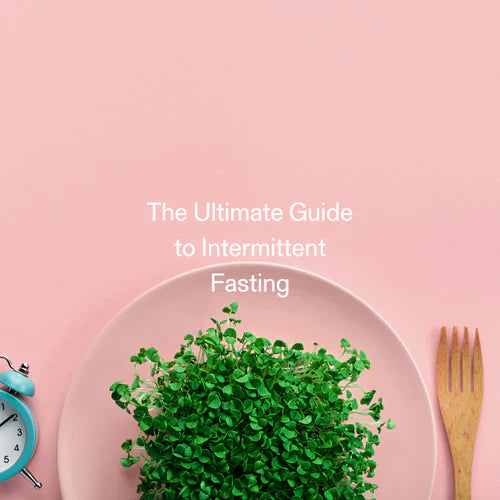
The Ultimate Guide to Intermittent Fasting
Intermittent fasting (IF) is a powerful dietary approach that has gained immense popularity recently for its potential health benefits and weight management effects. Rather than focusing on what you eat, intermittent fasting centres on when you eat, cycling between eating and fasting. This comprehensive guide will delve into intermittent fasting, explore various fasting methods, and provide practical tips for starting.
What is Intermittent Fasting?
Intermittent fasting is not a diet; it is a pattern of eating. It involves alternating periods of eating and fasting to extend the body's natural fasting period, known as the fasting window. This approach allows the body to access stored fat for energy, leading to potential weight loss, improved metabolic health, and other health benefits.
There are several popular methods of intermittent fasting:
- 16/8 method: Also known as the Leangains protocol, this involves fasting for 16 hours each day and consuming all daily calories within an 8-hour eating window.
- 5:2 method: This approach involves eating regularly five days a week and significantly reducing calorie intake (around 500-600 calories) on two non-consecutive fasting days.
- Eat-Stop-Eat: In this method, you fast for 24 hours once or twice a week.
- Alternate-day fasting: This approach involves alternating between regular eating and fasting days, where you consume very few calories or none.
- The Warrior Diet: This method involves a 20-hour fasting window followed by a 4-hour eating window daily.
How to Intermittent Fast
Getting Started
Getting started with intermittent fasting can be both exciting and challenging. Follow these steps to ease into the fasting routine:
- Choose the method that suits you: Assess your lifestyle, preferences, and health goals to determine the intermittent fasting method to suit you best.
- Gradual adjustments: If you're new to fasting, ease into it by gradually increasing the fasting window. Start with a 12-hour fast and add an hour each day until you reach your desired fasting duration.
- Stay hydrated: During fasting periods, ensure you drink plenty of water to stay hydrated and help curb hunger.
- Eat balanced meals: When it's time to eat, focus on nutrient-dense, whole foods that provide essential vitamins and minerals to support your health.
- Listen to your body: Pay attention to how your body responds to fasting. If you feel unwell or exhausted, consider adjusting your fasting schedule or seeking medical advice.
- Use Calocurb: Calocurb can be an incredibly effective tool to help you manage cravings and hunger in your fasting period and support a balanced appetite when entering your eating window.
Intermittent Fasting and Extended Fasting Guide
Intermittent Fasting Guide
- Start with the 16/8 method: This method is the most straightforward and is generally well-tolerated by most individuals.
- Avoid overeating during eating windows: Intermittent fasting is not an excuse to consume unhealthy or excessive amounts of food during your eating periods.
- Prioritise nutrient-rich foods: Opt for whole grains, lean proteins, healthy fats, and abundant fruits and vegetables to fuel your body correctly.
- Be patient: It may take a few weeks for your body to adapt to intermittent fasting fully, so be patient and allow time for adjustment.
Sample 16/8 Intermittent Fasting Schedule
- 8:00 AM - 12:00 PM (Fasting Period)
- Upon waking up, drink a glass of water to stay hydrated.
- Avoid consuming any calories during this fasting period.
- You may have black coffee or plain herbal tea if desired, as they typically have minimal or no calories.
- Take 1-2 Calocurb.
- 12:00 PM (Eating Window)
- Break your fast with a nutritious meal with balanced protein, healthy fats, and fibre-rich carbohydrates.
- Example: A salad with grilled chicken or tofu, mixed greens, avocado, nuts, and a light dressing.
- 3:00 PM (Snack)
- Enjoy a healthy snack if you feel hungry or need an energy boost.
- Example: A piece of fruit, Greek yogurt with berries, or raw veggies with hummus.
- 6:00 PM (Dinner)
- Have a well-balanced dinner that includes lean protein, healthy fats, and a variety of vegetables.
- Example: Grilled fish with quinoa and steamed vegetables.
- 7:00 PM - 8:00 PM (Snack)
- Keep it light and easy to digest to promote restful sleep.
- 8:00 PM - 8:00 AM (Fasting Period)
- Enter the fasting phase again and avoid consuming any calories during this time.
- Drink water or herbal tea if you need to quench your thirst.
Extended Fasting Guide
- Prepare your body: Before attempting a long fast, consult a healthcare professional, especially if you have any underlying health conditions.
- Start with shorter fasts: If you're new to extended fasting, try a 24-hour fast first, and only proceed to longer fasts when you feel comfortable and confident.
- Stay mindful of your body's signals: Pay attention to signs of dizziness, weakness, or extreme hunger during long fasts. Break the fast and eat a small, balanced meal if these symptoms occur.
- Break the fast gently: After an extended fast, reintroduce food gradually to avoid digestive discomfort.
Sample 24-Hour Extended/Alternate Day Fasting Schedule
- 8:00 AM: Last meal before starting the fast. Choose a balanced meal with nutrients that will sustain you during fasting.
- 12:00 PM: The fasting period officially begins. Stay hydrated and take Calocurb throughout the day.
- 8:00 AM (Next Day): This marks the completion of the 24-hour fast. Break your fast with a balanced and nutritious meal.
By responsibly incorporating intermittent fasting into your lifestyle, you can unlock the potential for a healthier, more energetic you. Sustainable changes and patience are key to long-term success on your intermittent fasting journey.
